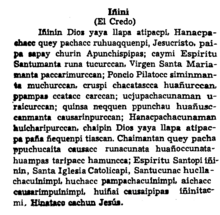
Back Quítxua clàssic Catalan Klassisches Quechua German Lengua general quechua Spanish Lenga quechua, classical PMS Inka qhichwa simi Quechua Классический кечуа Russian
This article should specify the language of its non-English content, using {{lang}}, {{transliteration}} for transliterated languages, and {{IPA}} for phonetic transcriptions, with an appropriate ISO 639 code. Wikipedia's multilingual support templates may also be used. (August 2021) |
| Classical Quechua | |
|---|---|
| Colonial Quechua | |
| Region | Peru |
Quechuan
| |
| (colonial) Latin script (Quechua alphabet) | |
| Official status | |
Official language in | Inca Empire |
| Language codes | |
| ISO 639-3 | qwc |
| Glottolog | clas1251 |




Classical Quechua or lengua general del inga is either of two historical forms of Quechua, the exact relationship and degree of closeness between which is controversial, and which have sometimes been identified with each other.[1] These are:
- the variety of Quechua that was used as a lingua franca and administrative language in the Inca Empire (1438–1533)[2] (henceforward Inca lingua franca[3]). Since the Incas did not have writing, the evidence about the characteristics of this variety is scant and they have been a subject of significant disagreements.[4]
- the variety of Quechua that was used in writing for religious and administrative purposes in the Andean territories of the Spanish Empire, mostly in the late 16th century and the first half of the 17th century and has sometimes been referred to, both historically and in academia, as lengua general 'common language'[5][6][7][8] (henceforward Standard Colonial Quechua[9]). It is Standard Colonial Quechua in this second sense that is abundantly attested in writing, notably in the famous Huarochirí Manuscript, and that this article primarily describes.
There are also some less common and typical uses of the term "classical" in reference to other Quechua varieties, whose relationship to the abovementioned ones is also controversial, namely:
- In reference to all use of Quechua as a literary medium until a cut-off point in the 18th century, which saw a ban on literature in Quechua after the Túpac Amaru rebellion of 1780–1782,[10] although the language of most of the "Classical Quechua literature" written after the mid-17th century is more commonly seen as early Cuzco Quechua;[11]
- As "Classic Inca", in reference to the reconstructed ancestor of all Southern Quechua varieties ("Common southern Peruvian Quechua").[12]
- ^ See Itier (2000: 47) for the distinction between the first and second enumerated senses, and the quote below for their partial identification.
- ^ Snow, Charles T., Louisa Rowell Stark. 1971. Ancash Quechua: A Pedagogical Grammar. P.V 'The Quechua language is generally associated with the "classical" Quechua of the Cuzco area, which was used as a lingua franca through Peru and Bolivia with the spread of the Inca Empire'
- ^ Following the terminology of Durston 2007: 40
- ^ Durston 2007: 40, 322
- ^ Beyersdorff, Margot, Sabine Dedenbach-Salazar Sáenz. 1994. Andean Oral Traditions: Discourse and Literature. P.275. 'the primarily catechetical domain of this lingua franca – sometimes referred to as "classical" Quechua'...
- ^ Bills, Garland D., Bernardo Valejo. 1969. P. XV. 'Immediately following the Spanish Conquest the Quechua language, especially the prestigious "classical" Quechua of the Cuzco area, was used as a lingua franca throughout the Andean region by both missionaries and administrators.'
- ^ Cf. also Durston (2007: 17): 'The 1550–1650 period can be considered both formative and classical in relation to the late colonial and republican production'.
- ^ See e.g. Taylor 1975: 7–8 for the dating and the name lengua general and Adelaar 2007: 183 for the dating
- ^ Following the terminology of Durston (2007: 40)
- ^ Mannheim 1991b: 74–75
- ^ Cite error: The named reference
Adelaar183was invoked but never defined (see the help page). - ^ Rowe 1950, cited in Mannheim (1991b: 114). Note that this pre-supposes identity with the Inca lingua franca, whereas Rowe's sources are primarily from the 17th century, i.e. Standard Colonial Quechua
© MMXXIII Rich X Search. We shall prevail. All rights reserved. Rich X Search